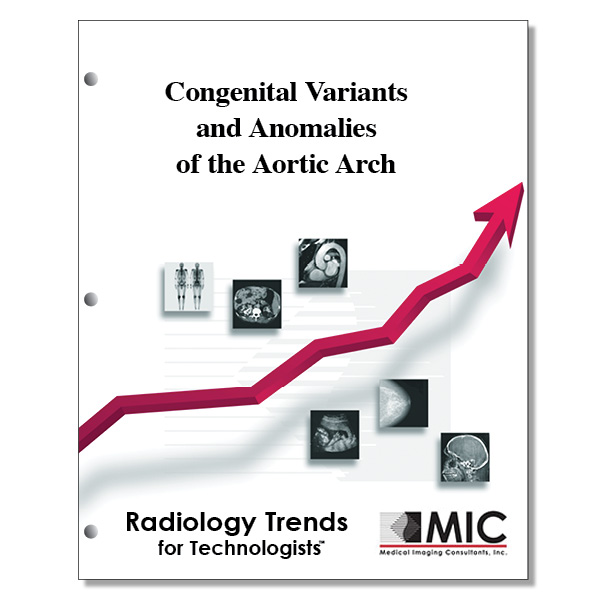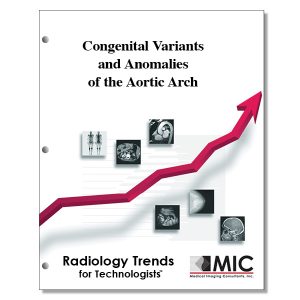

Congenital Variants and Anomalies of the Aortic Arch
A review of the cross-sectional imaging modalities used in the evaluation of the aortic arch along with a presentation of aortic arch variants, anomalies, and malformations.
Course ID: Q00531 Category: Radiology Trends for Technologists Modalities: Cardiac Interventional, CT, MRI, Sonography3.0 |
Satisfaction Guarantee |
$34.00
- Targeted CE
- Outline
- Objectives
Targeted CE per ARRT’s Discipline, Category, and Subcategory classification for enrollments starting after January 30, 2024:
Computed Tomography: 3.00
Procedures: 3.00
Neck and Chest: 3.00
Magnetic Resonance Imaging: 3.00
Procedures: 3.00
Body: 3.00
Registered Radiologist Assistant: 3.00
Procedures: 3.00
Neurological, Vascular, and Lymphatic Sections: 3.00
Outline
- Introduction
- Imaging
- Embryology and Anatomy
- Arch Variants and Anomalies
- Normal Left Aortic Arch and Variants
- Left Aortic Arch with Aberrant Right Subclavian Artery
- Left Aortic Arch with Diverticulum of Kommerell
- Sidedness of the Ligamentum Arteriosum or Ductus Arteriosus
- Left Circumflex Aorta
- Right Aortic Arch with Aberrant Left Subclavian Artery Arising from a Retroesophageal Diverticulum
- Right Aortic Arch with Aberrant Left Subclavian Artery without a Retroesophageal Diverticulum
- Right Aortic Arch with Aberrant Brachopcephalic Artery
- Right Aortic Arch with Mirror Image Branching
- Right Arch with Isolation of the Left Subclavian Artery
- Right Circumflex Aorta
- Double Aortic Arch
- Cervical Aortic Arch
- Persistent Fifth Aortic Arch
- Interrupted Aortic Arch
- Type A IAA
- Type B IAA
- Type C IAA
- Hypoplasia, Coarctation, and Pseudocoarctation
- Aortic Arch Hypoplasia
- Coarctation
- Pseudocoarctation
- Conclusion
Objectives
Upon completion of this course, students will:
- list the features and signs that raise suspicion for a vascular ring
- note the importance of detailed evaluation of aortic arch anatomy
- list the imaging modalities used to identify and diagnose aortic arch variants and anomalies
- state the imaging modality used in the pediatric setting for diagnosis of aortic arch variants and anomalies
- name the disadvantages of CT angiography in pediatric patients
- identify the non-radiation imaging modality used for evaluation of the aortic arch
- explain when aortic arch development begins
- describe the two major parts of the primitive aorta
- indicate the number of paired primitive aortic arches that develop between the ventral and dorsal aortae
- state the branches of the primitive third aortic arch
- explain how soon the ductus arteriosus closes after birth
- list the three basic congenital anomalies of the aortic arch
- state where a normal left arch crosses the spine
- list the branches arising from a normal left aortic arch
- recall the percent of patients with a typical aortic branching pattern
- express the most common congenital anomaly of the aortic arch
- explain the percent of patients with trisomy 21 that have a left aortic arch with aberrant right subclavian artery anomaly
- recall the percent of adult patients with symptomatic dysphagia associated with a left aortic arch with aberrant right subclavian artery anomaly
- describe the origin of the Kommerell diverticulum
- describe the location of the arch in relationship to the esophagus in patients with a left circumflex aorta
- discuss the most common variation of a right aortic arch
- list the most common causes of a vascular ring
- state the aortic arch anomaly that is rarely associated with congenital heart disease
- state the aortic arch anomaly associated with tetralogy of Fallot
- list the aortic branches for patients with a right aortic arch with aberrant brachiocephalic artery anomaly
- state the second most common right aortic arch anomaly
- recall the percentage of right aortic arch with mirror image branching that is associated with congenital heart disease
- indicate the number of ipsilateral breaks in the aortic arch system that causes isolation of arch vessels
- list the branches in order coming off of the aorta for a right aortic arch with isolation of the left subclavian artery anomaly
- state the alternative name for a right aortic arch with a left descending aorta and left ductus arteriosus or ligamentum arteriosum
- choose the arch anomaly that may require an aortic uncrossing procedure for relief of symptoms
- describe the aortic arch anomaly that is the most common cause of a symptomatic vascular ring
- list the clinical manifestations of a double aortic in children and infants
- compare the right and left aortic arch appearance in a double aortic arch anomaly
- state the number of proposed theories explaining the development of cervical arches
- state the number of embryos that experience degeneration of a fifth aortic arch
- list the connections that may be made by a persistent fifth aortic arch
- state the number of interrupted aortic arch types
- choose which type of interrupted aortic arch is associated with chromosome 22q11 microdeletion
- describe normal tapering time for the distal aortic arch
